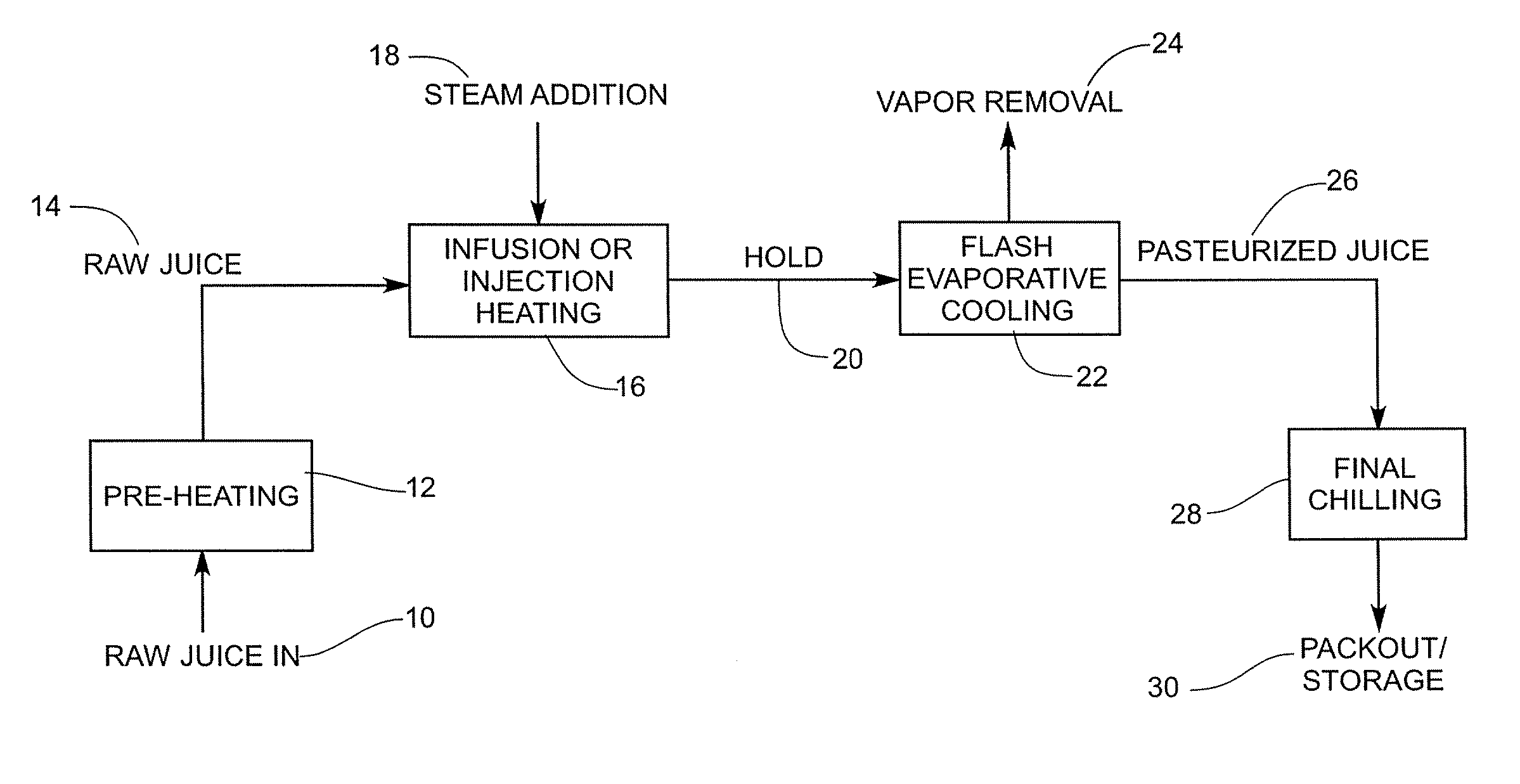Reduction of oil and off-flavors in citrus juice by direct steam heating and flash cooling
a technology of citrus juice and flash cooling, which is applied in the field of direct steam heating of citrus juice, can solve the problems of significant product degradation, and adversely affecting the taste of the juice, and achieves the effects of reducing oil content, reducing oil content, and improving tas
- Summary
- Abstract
- Description
- Claims
- Application Information
AI Technical Summary
Benefits of technology
Problems solved by technology
Method used
Image
Examples
example 1
[0044] Single strength stored blends of NFC orange juice were tested. The juice contained 40-50% previously frozen whole juice, with the remaining juice in the mixture being freshly extracted juice. The juice was steam pasteurized by steam injection or steam infusion, and a control juice was tubular pasteurized and not steam pasteurized. The steam pasteurized juice was first pre-heated to 100° F. (37° C.) and then steam pasteurized by steam injection or steam infusion to 205° to 207° F. (96° C. to 97° C.) for 0.4 seconds followed by flash cooling to a temperature of 100° F. For the steam pasteurized juice, product residence time above 100° F. (37° C.) was minimized to within 1 second. The indirect tubular process (control juice) involved pasteurization for 3 seconds at 195° F. (90.5° C.), followed by conventional cooling. Samples of the steam pasteurized juice and control juice were collected and stored in one quart glass bottles at 35° F. (2° C.). The samples of the steam pasteuriz...
example 2
[0049] Pasteurization of FC orange juice was tested using direct steam infusion compared with indirect tubular heat exchange (control). The steam infusion procedure involved preheating to 100°° F. (37.8° C.), then pasteurizing for 3 seconds at 200° F. (93.3° C.) by direct steam infusion, and then flash cooling to the preheat temperature. The pasteurization was done for 3 seconds based on the equipment available to compare results to the indirect tubular procedure. The indirect tubular procedure (control juice) involved pasteurizing for 3 seconds at 200° F. (93.3°). The control juice was not preheated prior to pasteurization heating. The control juice was cooled by a tubular cooling system. The juices from both procedures were then cold-filled in quart glass bottles, stored at 35 ° F. (2° C.) and evaluated after 4 weeks of storage for sensory characteristics.
[0050] At four weeks, the juice was tasted by a panel using the 15-point anchored universal line scales described in Example 1...
example 3
[0052] Various juice streams were tested with steam injection system as an alternative pasteurization technique. Fresh Hamlin, fresh Valencia juice, NFCOJ blend juice, FCOJ, and split streams of high solids and low solids were used as the juice source. One item of interest is to compare the oil reduction of the method of the present invention on a typical single strength juice versus using the method on juice that has been separated into a high solids stream and a low solids stream. The juice in this test was pre-heated to temperatures between 140° F. to 160° F., then steam heated to approximately 205° F. The juice was held at the high temperature for a period of time between 0.7 to 1.5 seconds. The juice was then flash cooled to the pre-heat temperature. Table 3 summarizes the oil removal efficiency results
TABLE 3Average / RangeSourceinitial oilfinal oil% reductionSDNo. of testFresh Hamlin0.0170.00854.62.32Fresh Hamlin, low solids stream0.0160.00381.31Fresh Hamlin, high solids stre...
PUM
 Login to View More
Login to View More Abstract
Description
Claims
Application Information
 Login to View More
Login to View More - R&D
- Intellectual Property
- Life Sciences
- Materials
- Tech Scout
- Unparalleled Data Quality
- Higher Quality Content
- 60% Fewer Hallucinations
Browse by: Latest US Patents, China's latest patents, Technical Efficacy Thesaurus, Application Domain, Technology Topic, Popular Technical Reports.
© 2025 PatSnap. All rights reserved.Legal|Privacy policy|Modern Slavery Act Transparency Statement|Sitemap|About US| Contact US: help@patsnap.com



